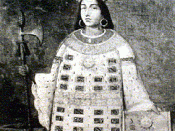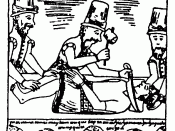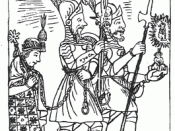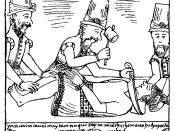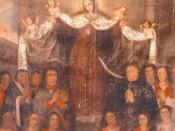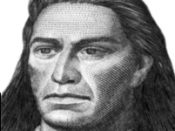Most of the Bodies were contained in 'mummy bundles' which held up to seven individuals. Nearly half of the bodies found were children who most likely suffered from anaemia. They then realised they had come across the second largest cemetery ever excavated in Peru and the largest from a single time period.
Two Mummies from the Inca un-wrapped from the mummy bundles
During the years of 1991, 2000 and 2001 excavations took place to recover more mummies and artefacts of the Inca civilisation which lived between: 1438-1532. The Location of this town in which the Mummies were found is near the central coast of Peru, the area hardly gets any rain and is very dry which results in the remains of the past being preserved very well. Dry climates allow the preservation of ancient bodies and artefacts by heat and absence of moisture which prevents decay. The fabrics and embalmment which were around the bodies helped alot as they absorbed moisture very quickly. Preservation through dry climates combined with embalming and the mummy bundles is a very effective technique as you can see from the above image.
The Cotton King being unwrapped carefully
The vast majority of the bodies had no visible injuries, so archaeologists presume that this was a normal burial site for natural deaths and deaths from diseases.
One of the biggest mummy bundles was nicknamed the 'Cotton King' because he was wrapped in 300 pounds of raw cotton, they knew he must have been high in the social class as they normally only wrapped nobles in finished cloth, it took weeks to unveil the bundle making sure no artefacts were kept within the bundles of cotton.
Many Mummy Bundles in storage waiting to be examined
Mummy Bundles provided a thick but not-so-solid protection for the dead bodies. The tight thickness of the bundles provided a shield from moisture reaching the body and damage to be caused the body from the outside. The Inca's also put food and personal belongings in the bundles, which in some still remain in almost perfect preservation.
An Elaborate headdressThe Mummy Bundles showed how the Inca people clothed themselves. We can tell just by looking at some of the clothes that the Inca's were 'masters of elegance'. For example an elaborate headdress was found which had imported feathers and fish designs. The crown was a foot-tall which also had two earflaps, and long panel that draped down the back of the wearer, who would have been a person of a very high rank. There was also another perfectly preserved woven bag which showed that the Inca's were real masters of weaving such fabrics to make a bag with a melody of colours and fabrics.
"Carefully tended after death, both young and old were well equipped for immortality"
-National Geographic Magazine.
We believe the reason for them to place these objects with the bundles, was because the Inca's believed in an afterlife and that when they wake up in the other life they will need plenty of food and belongings. This is a perfect example of how the Inca's tells us that they had a religion and practiced it throughout their civilisation.
Today biological anthropologists and bio-archaeologists are still investigating different aspects of population dynamics, ethnicity, diet, health and disease, growth and development, mortuary behaviour and more. The excavation is still going and they have found many more things than mummies such as; buildings, residences, walls, floors, 20 tombs and other vestiges, which suggested the possibility of a previous civilization, different from the Incas.
20047194
